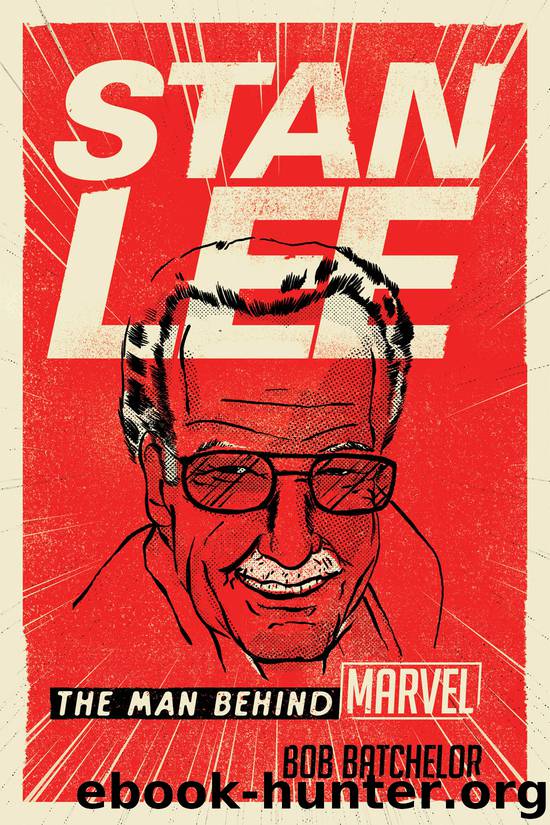Stan Lee by Bob Batchelor

Author:Bob Batchelor
Language: eng
Format: epub
ISBN: 9781442277823
Publisher: Rowman & Littlefield Publishers
Published: 2017-06-27T04:00:00+00:00
The popularity of Marvel’s offbeat superheroes turned it into the hip 1960s comic book house, but DC still controlled the industry if sales figures were the principal measure. The ongoing competition between the publishers loomed large and focused each on outdoing the other. DC counted on the long-standing heroes in its stable—Batman, Superman, and Wonder Woman, while Lee and Marvel countered with the hip Spider-Man, Thor, and the Fantastic Four. The popular current seemed to tip toward Marvel, but then the ABC television series Batman debuted in January 1966. In a unique programming move, the show aired two nights a week—Wednesday and Thursday—in half-hour segments.
The instant success of the series made an immediate impact on the comic book industry and enabled DC to regain some of its swagger. With actor Adam West as the Caped Crusader and Burt Ward as the youthful sidekick, Robin, the series perfectly mixed camp and action in a way that appealed to contemporary audiences. It served up a steady stream of one-liners and plenty of “POW,” “BAM,” and “ZONK” to delight audiences across age groups. The music alone propelled the show, a mix of 1960s pop-infused soundtrack mixed with Batman-specific tunes that were catchy and stuck in listeners’ heads like an earworm. Batman also took advantage of the color television craze, using bright color schemes to bring the comic book characters to life.
After half a decade of searching for the magic decoder ring that would open an inroad to Marvel readers, DC seemed to finally capture the voice that Lee brought to comics. Batman captured the nation’s growing fascination with superheroes, especially in its satirical tone, which Lee had brought to the medium. In many respects, the snarky banter of the two heroes seemed closer in alignment to Spider-Man or the Fantastic Four than anything DC had recently produced.
Television grew so pervasive during the mid-1960s that DC benefited, but its popularity really raised sales across the board. All the major publishers saw sales increase, with Harvey Comics introducing superheroes Spyman and Jigsaw, while Tower Comics brought out Dynamo and Noman. Marvel attempted to counter Batman to some degree by beginning Thor’s solo run in March 1966 and then debuting the Black Panther, the first African American superhero, in Fantastic Four #52 (July 1966).
Lee and Kirby did not let the Batmania thwart their efforts to further round out the Marvel Universe. As a kind of counterbalance, they introduced a three-part trilogy in Fantastic Four #48–50 (March–May 1966) that had the original supergroup battling Galactus, an omnipotent superbeing who sustained life by devouring the energy from entire planets. The epic trilogy pitted Marvel’s most powerful villain against Earth’s powerful superhero team. A comic book arc would have trouble competing head-to-head against a popular television series, but Marvel hoped to at least increase sales and entice more readers to pick up the comic.
Lee’s aggressive antics to expand the comic book marketplace started to draw in a broader range of readers, but the change took place gradually. As late
Download
This site does not store any files on its server. We only index and link to content provided by other sites. Please contact the content providers to delete copyright contents if any and email us, we'll remove relevant links or contents immediately.
4 3 2 1: A Novel by Paul Auster(11078)
The handmaid's tale by Margaret Atwood(6876)
Giovanni's Room by James Baldwin(5896)
Big Magic: Creative Living Beyond Fear by Elizabeth Gilbert(4736)
Asking the Right Questions: A Guide to Critical Thinking by M. Neil Browne & Stuart M. Keeley(4602)
On Writing A Memoir of the Craft by Stephen King(4223)
Ego Is the Enemy by Ryan Holiday(4004)
Ken Follett - World without end by Ken Follett(3984)
The Body: A Guide for Occupants by Bill Bryson(3821)
Bluets by Maggie Nelson(3725)
Adulting by Kelly Williams Brown(3682)
Guilty Pleasures by Laurell K Hamilton(3602)
Eat That Frog! by Brian Tracy(3529)
White Noise - A Novel by Don DeLillo(3443)
The Poetry of Pablo Neruda by Pablo Neruda(3373)
Alive: The Story of the Andes Survivors by Piers Paul Read(3322)
The Book of Joy by Dalai Lama(3239)
The Bookshop by Penelope Fitzgerald(3238)
Fingerprints of the Gods by Graham Hancock(3224)
